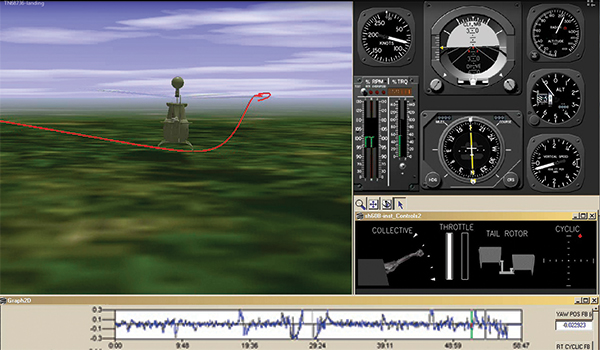
Tech Talk / By Mr. Christopher “Kit” Borden: The Aviation Engineering Directorate (AED) often uses simulations to recreate aircraft flight in order to support the airworthiness mission.

Mr. Christopher “Kit” Borden is the executive officer of the Aviation Engineering Directorate of the U.S. Army Aviation and Missile Research, Development, and Engineering Center at Redstone Arsenal, AL.
A screen capture of an AED visualization simulation / AMRDEC AED SCREEN CAPTURE
There are two main types of simulations AED uses: visualization, which is used to help understand “what” happened, and physics-based simulation that is used to examine “how” or “why” things occurred. Visualizations may be used to recreate events in flight such as anomalies or accidents or to review training flights, whereas physics-based simulation can also be used to predict how an aircraft will behave.
Visualization
A visualization type simulation is only possible with data about the “state” (its position in space, attitude, and linear and angular rates at each point in flight) of the aircraft during the event. This is usually enabled by recorded flight data. One useful feature is the ability to examine time-linked recorded data, permitting engineers to examine cause and effect as well as delays or lags between inputs and responses. Another useful output of a visualization is the ability to view an event from multiple points of view. These views might include inside the cockpit, a chase plane, or a combination of several points of view simultaneously. These recreated views can also be combined with recorded audio and video when available.
The usefulness of a visualization is dependent on the quality of the input data. If something wasn’t recorded, then it isn’t available. The data rate and precision on the data are also important. As you can imagine, aircraft pitch attitude data recorded every 30 seconds and to the nearest +/- 5 degrees isn’t very helpful in understanding a dynamic maneuver. However, recording 50,000 parameters every 1/1000th of a second is not only difficult to do, but the resulting data files are impossibly large. Engineers generally want more data, so no matter how much or how fast the data is recorded, we’ll always want more, and a balance needs to be met.
While the Army’s Combat Readiness Center/Safety Center leads accident investigations, AED supports them with engineering expertise. This includes creating visualizations of the events. And sometimes it involves using physics-based models to “fill in the blanks”.
Physics-Based Simulation
Physics-based simulation is used to provide insight where there is no data or where recorded data is insufficient. This type of simulation requires a good engineering model based on a deep understanding of the aircraft. These are not video games. As part of the development of any engineering model, it is compared to flight test data in order to validate and prove the accuracy and correctness of the model. This correlation with actual aircraft data is what provides the confidence in the model when used to predict the behavior of the aircraft where there is no recorded data. These models can help engineers and investigators study possible scenarios.
Some physics-based simulations can be used as the basis of a piloted simulator both for aircraft development and for training. This sometimes leads to compromises between modeling the dynamics of the aircraft from an engineering perspective and ensuring that the pilot has the “correct” flight-representative experience. The exact compromises depend on the purpose of the simulator, with training simulators focused purely on the pilot experience and engineering sims more focused on the physics.
Physics-based models can be used to create “virtual flight test data” from conditions that are impossible or unreasonable to gather with manned aircraft. These may include flight conditions outside the safe envelope of the aircraft, maneuvers that would damage real aircraft, or even simulated structural failures or severely damaged aircraft. These models can also be driven by recorded pilot inputs or by a “virtual pilot” in order to create perfectly repeatable tests. In these cases, visualization of the physics-based simulations can also be used to check that the results are reasonable.
AED has built and maintains engineering models of the Apache, Black Hawk, and Chinook, among others. These models are used to support AED’s airworthiness mission by providing insight into the behavior of the Army’s helicopters. These simulations model the aerodynamics of the rotors, fuselage, and tail. They also model the engine performance, weight and balance, and the flight control system. After extensive correlation with flight test data, AED uses these models to understand and predict the performance and handling qualities of Army rotorcraft. They also get utilized outside of AED as the physics models in piloted simulators and hardware-in-the-loop systems integration labs. The better AED teaches computers to pretend to be helicopters, the better we can help Army Aviation be safer and more effective.







